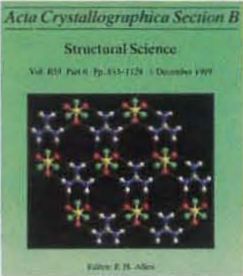


IUCr journals news
The powder diffraction handicap
Acta Cryst. B55 (1999), 1068-1074
Acta Cryst. B55 (1999), 1075-1089

With almost 400 ab initio structure determinations reported, powder diffraction is healthier than ever. In the last 10 years, a proliferation of new methods has extended our capability to extract detailed structural information from powder patterns. Two recent papers in Acta Cryst. B illustrate the strength of current methods.
The classical approach, Patterson and direct methods applied to the extracted “|Fobs|”, accounts for three-quarters of powder diffraction studies, but the most active area of research involves locating molecular fragments in known crystalline cells. Methods that use either a systematic grid search or a Monte Carlo calculation, simulated annealing and genetic algorithms have been applied successfully to nearly 50 powder patterns. A good example of such an application is described by Tremayne et al. [“2,4,6-Triisopropylbenzenesulfonamide: Monte Carlo structure solution from X-ray powder diffraction data for a molecular system containing four independent asymmetric rotors”, Acta Cryst. B55 (1999), 1068-1074], who used the OCTOPUS program. The difficulty of application depends upon the number of degrees of freedom that a structure has, and increases with each independent torsion angle. Analogous single-crystal methods use Patterson and/or direct methods to position rigid models (e.g., PATSEE or DIRDIF programs). Because of reflection overlap – the powder diffraction handicap – the use of direct-space data is required to determine the position and conformation of a model.
The solution of a structure with unknown cell parameters using ab initio packing calculations is much more difficult. There are few successful applications of this approach, which requires previous knowledge of a quasi-complete molecule. In their paper, Karfunkel et al. [“Local similarity in organic crystals and the non-uniqueness of X-ray powder patterns”, Acta Cryst. B55 (1999), 1075-1089] elucidate the crystal structure of some diketopyrrolopyrrole derivatives with surprisingly similar powder patterns, and introduce two new concepts for molecular solids, “local similarity” and “boundary-preserving isometry”. The degree of difficulty of indexing powder patterns is related to the complexity/resolution ratio. Crystallinity may strongly affect resolution. Poorly resolved powder patterns increase the ambiguity and decrease the accuracy of a structural model. The ability of distinctly different models to fit a powder pattern equally well is a recurring problem.
Owing to its one-dimensional nature, powder diffraction is less reliable than single-crystal analysis. Both of these articles address this problem. The high R factor in the Monte Carlo study (RF = 0.10 for 517 reflections, 143 refined parameters, 120 geometrical restraints) suggests a problem with the model (a “local similarity” problem?) or the data. How wrong can structures determined from powder data be? The same question may be addressed to all underdetermined structural problems, including proteins, some of which are also being examined by powder diffraction!
The one-dimensional nature of powder diffraction will never be overcome. Consequently, a single-crystal study is always preferable to a powder study, when possible. The failure to obtain single crystals of many materials is the driving force behind the powder diffractionists’ quest for innovation. New methods such as those described in these articles (or at least those that are affordable, see http://sdpd.univ-lemans.fr/iniref/progmeth.html) may well stimulate crystallography as a whole.
Armel Le Bail, U. du Maine, Le Mans, France

